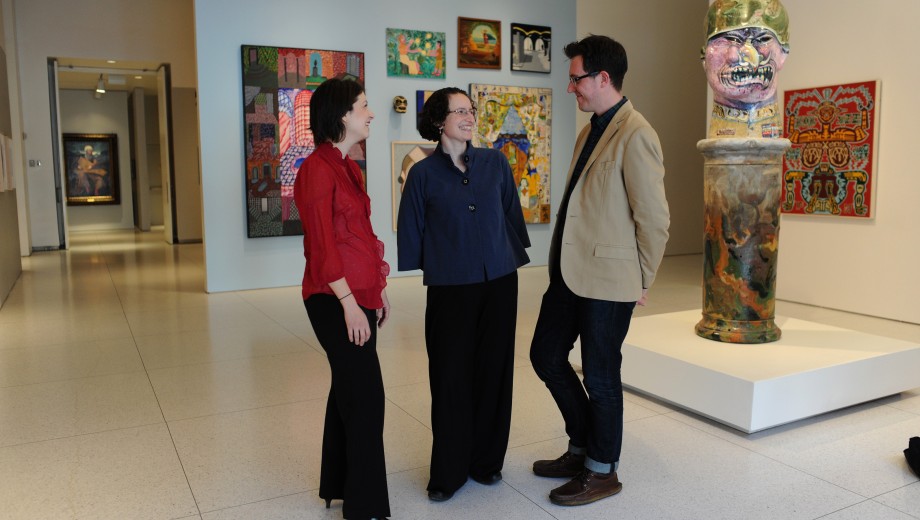“I don’t look like a regular art historian,” admits Niall Atkinson.
His shoulder-length blond hair says “surfer” more than “professor,” but Atkinson, a Neubauer Family Assistant Professor in Art History, isn’t referring to his physical looks. His area of study—the soundscape of Renaissance-era architecture and urbanism—falls outside the usual boundaries of art history. The five other recent hires in the department share his adventurous approach. “We all have that offbeat quality,” says Cécile Fromont. “It’s exciting to be a part of that cohort.”
Recruiting scholars is not a task the department takes lightly. Professor Christine Mehring, chair of the department, notes that faculty searches can take several tries before a committee finds the right candidate. Instead of hiring to fill a gap in the curriculum, Mehring
explains, they search for the best scholarship. “We seek quality, we seek a great mind—we seek great work that isn’t attached to ‘this’ kind of art history or ‘that’ kind of art history.” This open approach is something the new faculty members recognize as a strength. “We’re all a little quirky, and that’s something the department prides itself on,” says Claudia Brittenham.

During the 1980s and ’90s, Mehring argues, the department was known as a “hotbed” of theoretical and philosophical analysis. She believes that art historians in general are making a return to the object—“in many ways the shared ground of our discipline”—as a focus of study. Mehring praises the department’s assistant professors for building on the work of a previous generation of scholars to combine both “material object and conceptual sophistication” in their research.
The group’s research interests point to another shift. Art history today is “a more even field” than it used to be, observes Mehring, with thriving subfields that span the globe and cross centuries of civilizations. Incorporating artistic traditions from outside Europe or North America “is something our department is doing very well,” adds Fromont. She studies visual manifestations of cross-cultural connections in the early modern Atlantic world, from images in political and scientific texts to seventeenth-century crucifixes from the Kingdom of Kongo.
“My work is in between many fields,” says Fromont, adding that cross-pollination between subfields can only improve scholarship. Even within more traditional fields such as European or American modern art, she believes that research is “made more interesting by collaboration with those working on modern art elsewhere.”
Many of the assistant professors are not so much focused on one particular area of art but on the interplay between regions and peoples. Chelsea Foxwell, a specialist in nineteenth-century Japanese art, examines how cross-cultural exchanges after Japan’s so-called opening to the West affected the country's art. Both Foxwell and Ping Foong, a scholar of early Chinese art, take advantage of what Foxwell says is “a special sense of energy and collaboration on campus,” working with colleagues in the Department of East Asian Languages and Civilizations and the Center for East Asian Studies. “I seek their advice all the time,” Foxwell says.
Brittenham, who studies Mesoamerica in the 3,000 years before the Spanish invasion, also finds it easy to connect with her colleagues. She and the newest member of the department, Patrick Crowley, both work with the department’s Center for Global Ancient Art. Crowley’s research in ancient Roman visual culture looks at images of ghosts and how they play into ideas about the reliability of vision and notions of truth.
On the surface, Brittenham’s work on pre-Columbian mural paintings has little to do with Crowley’s investigations of ghost images on ancient Roman sarcophagi. But Brittenham finds that comparing methodologies, findings, evidence—or even what counts as evidence—between their areas of study “shakes things loose” that she can take back to her own research.
For younger faculty members, it can be difficult to balance teaching with research, but they enjoy working with students who often surprise them with original insights. In art history, says Brittenham, “the barriers to access are so low. All you need is a pair of eyes to do original research.” The students are “so engaged, so fearless.” Discussing his recent Introduction to Roman Art and Archaeology course for undergraduates, Crowley notes, “even though no one in my class is an art history major, it doesn’t matter—they all have things to say.”
Despite their divergent research, the group shares “points of intersection and points of conversation,” says Brittenham. “We all like each other too.” Atkinson notes that their extended conversations also occur through students, with assistant professors regularly sending students to each other to “reproduce that ethos” of open exchange. “Students come in with conventional ideas about art history that I’m trying to undo,” says Atkinson. “I’m trying to get students to see that they can cross corridors.”


Add new comment